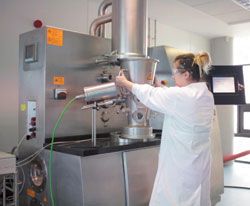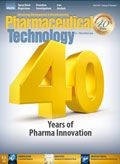Moving Toward Real-Time Release Testing
Real-time alternatives to dissolution testing are required for continuous manufacturing to reach mainstream use.
An Innopharma Labs researcher at work. The company is developing models to predict dissolution testing results in real time for controlled release formulations. Figure courtesy of Innopharma Labs.

One challenge that continuous processing faces is the difficulties of developing real-time alternatives to dissolution that would allow real-time release testing (RTRT), promised years ago by FDA’s process analytical technology (PAT) initiative, to be used with continuous manufacturing.
Progress has been made for more straightforward products, and Janssen Pharma is expected to file a post-approval change including RTRT for its continuous facility in Puerto Rico, according to Doug Hausner, associate director of the Engineering Research Center for Structured Organic Particulate Systems (C-SOPS), which helped Janssen develop the approach.
“The industry has made progress in developing process models, establishing a foundation for inputs and outputs to the system, understanding what needs to be controlled and modeling that,” says Hausner. “Manufacturers have also gained an understanding of how PAT fits into that picture, how much time you have to make a certain measurement and where that information needs to go.” Without a model for dissolution, however, you may be doing quality assurance (QA) online, but you aren’t truly releasing product in the regulatory sense, he says.
Offline methods
Currently, the only method widely applied in dissolution testing is the offline laboratory-based method of dissolving samples in heated, agitated liquid baths and drawing samples for spectral transmission analysis, says Chris O’Callaghan, senior product manager at Innopharma Technology, which develops near infra-red (NIR) PAT and visualization systems.
Innopharma has been collaborating with Glatt and other technology vendors who work in the continuous processing space to develop models that would enable real-time prediction of the release profile of a coated multiparticulate material in controlled-release formulas (1). The company is now working to improve and expand its predictive model, says O’Callaghan (Figure 1).
“As a method, dissolution is right up there with reading the entrails of goats,” says NIR spectroscopist Emil Ciurczak, principal of Doramax Consulting. “We want to know whether a tablet or capsule will break if moisture changes and whether it will extract and be available to the body. There’s a very tenuous dotted line between releasing in a 900-mL flask and blood levels. The testing is clinically done once, but they don’t really know, if after six months or a year if it changes, short of doing clinical studies on older batches,” he says.
While a clear need exists for an in-line real-time alternative to this method, development in the field has been limited, says O’Callaghan. The physical and chemical interactions governing the in-vitro dissolution process are highly complex and cannot be easily modeled from first principles based on the product data that are available inline, or accelerated in a way to make the testing applicable in-line, he says.
This leaves model-based prediction of dissolution performance based on measurable process parameters and critical quality attributes (CQAs) as the only possible real-time method available. Approaches using spectrometry or particle size have been discussed, but haven’t yet been widely adopted, due in part to the difficulty of modeling.
“The effects of multiple key processing parameters on the relationship between coating thickness and release profile are being studied in order to develop a more comprehensive dissolution prediction mechanism,” he says, noting that this would be a key control element for a new self-guided coating control system that the company is now developing. “The coating’s aim is to reduce waste and improve the speed in manufacturing of modified release products by aiding to maintain an optimal coating trajectory and rapid determination of the process end-point, with the ultimate goal of enabling true real-time release,” says O’ Callahan.
Advanced manufacturing: the next stage
The next stage of evolution will see pharma adopting advanced manufacturing techniques, for both batch and continuous, says Ian Jones, Innopharma’s CEO. “When we talk about advanced manufacturing, we think of the Industrial Internet of Things (IoT), Industry 4.0, machine-to-machine connectivity, and the adoption of artificial intelligence philosophies. All of these components can be used to develop and manufacture formulations in a more rapid, lean, and safe manner,” he says.
“In order for there to be a real opportunity for real-time release to be realized, these PAT techniques need to be combined with control models thereby enabling predictive control of these dynamic batch and continuous processes,” Jones says.
The company is now working to develop self-guided granulation and coating, and demonstrating their potential use in ‘hands off’ manufacturing at the company’s pilot plant in Dublin. “We can track CQAs of the process using our PAT tools, track and control the process in accordance with a model and activate the phase changes and endpoint based on our tools and models, monitoring progress from a mobile phone in real time,” says Jones.
Process signature is key
On a more basic level, for RTRT to take shape throughout pharma, the industry will have to change the way it views control. “Manufacturers have to understand that the process signature is key, and not the measurements and numbers you got out of the operation. Process signature shows that process is where it belongs, and that’s where RTRT comes in,” says Russ Somma, principal of Sommatech Consulting, noting that some companies are already at this point. “When they aren’t, it’s often because quality organizations are not comfortable with that approach,” he says.
Where dissolution testing is concerned, Somma worries about whether it will be used for process control, or for the patient. “In the end, the therapeutic window on a particular compound could be a lot wider, based on pharmacokinetics, than dissolution allows, and dissolution may have no direct relevance on effect, if, for example, the drug is very soluble,” Somma says.
With a poorly absorbed compound, however, the problem becomes more complex. “Until we get in-vitro in-vivo correlation really working well, we still have a lot of work to do,” he says.
Reference
1. P. Patel et al., “Predicting Multiparticulate Dissolution in Real Time for Modified and Extended Release Formulations,” Pharm. Tech, 2017 Solid Dosage Supplement, April 2017.
Article Details
Pharmaceutical Technology
Vol. 41, No. 7
Page: 54
Citation
When referring to this article, please cite it as A. Shanley, “Moving Toward Real-Time Release Testing,” Pharmaceutical Technology 41 (7) 2017.

Pharmaceutical Tariffs Are Imminent: How Industry is Bracing for Impact
April 16th 2025On April 14, 2025, the Trump Administration launched a national security-driven investigation into pharmaceuticals, a move that will likely result in tariffs being placed on pharmaceutical drugs, ingredients, and other components that are imported from outside of the United States.
